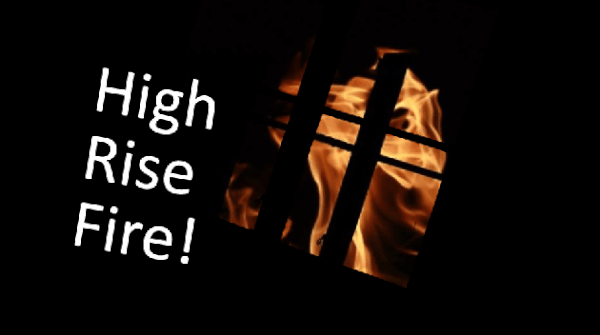5-point Safety Checkup for Daylight Savings Time Change
 Just waiting for you to make a mistake!
Just waiting for you to make a mistake!
It’s “Spring Forward, Fall Back” time here again this weekend. Along with re-setting the clocks, this time of year now has expanded to include reminders for emergency preparedness.
Of course, you know about checking the batteries in your smoke alarm. But that’s just the start! So read on, for some simple actions that if overlooked could put you in BIG trouble.
To the extent that your safety and security depend in part on your neighbors’ preparedness, be sure you share this list with them, too!
1-Change the batteries in your smoke alarm.
You should know this statistic from the National Fire Protection Association by heart: Three of every five home fire deaths resulted from fires in homes with no smoke alarms or no working smoke alarms. Nuff said?
And here’s a real life story to go with the statistic.
A couple of years ago on a Saturday, the local fire department, police department cadets, some EMTs, and the Red Cross, supported by our Neighborhood Emergency Response Team, installed 461 new smoke alarms in our neighborhood! (Funded by a grant, in case you’re wondering.)
The alarm packaging said, “10-year guarantee” so naturally we were all annoyed when people began reporting that their smoke alarms were “chirping.”
Here’s what we discovered about alarms chirping:
- Nearly all people who heard the chirping incorrectly identified where it was coming from! In nearly every case, it was from an already installed OLD alarm, and not the new one.
- The 10-year guarantee works for the mechanism. When it comes to the battery, the guarantee applies only to alarms that have sealed lithium batteries. If your smoke alarm has a replaceable battery, check it and replace it or it will surely start chirping, like ours did, in the middle of the night!
- Every battery has an indicated life. Just remember, you may buy new batteries today but you don’t know how much of that “life” has already expired while the battery was on a shelf somewhere.
Upshot? Simply replace your alarm batteries twice a year when the time changes. A few dollars invested can save your life.
2-Change the batteries in your walkie-talkies.
Same concept: when the emergency hits, if you don’t have fresh batteries, you may have lost an important tool.
Walkie-talkies take AA or AAA batteries. Over the years we have tested different brands and over the years the “winner” in the test has been different every time!
Get the right size, get the longest life available, and TEST them regularly. Every month we catch a couple of dead Walkie-Talkies during our monthly drill. (Of course, if people forget to turn the Walkie-talkies off after the drill, the chances of the batteries going bad are about 100%.) (And corroded batteries can destroy the walkie-talkie, too.)
Don’t have Walkie-talkies for your group or family? Here’s our walkie-talkie reviews to get you started on adding some.
3-Check your fire extinguishers and replace if they have lost pressure.
Fire extinguishers can last many years, but – Do you really remember when you bought yours?
A good extinguisher has a pressure gauge to help you track its functionality. Check the gauge when the time changes, if not more frequently. Not sure if the extinguisher is any good? Get a new one.
Looking to re-charge your extinguisher? We’ve looked, and haven’t found a reasonably-priced service. Maybe you can find one, but chances don’t seem to be very good.
4-Refresh your first aid kits.
We’ve written before about the drawbacks of most purchased first aid kits.
Still, you’ll want to start with a basic kit, and add your own enhancements.

Any first aid kit needs customization, and that’s where a regular check-up is important. At the time change, pull together all your kits (from your cars, your Go-Bags, etc.) and look in particular for . . .
- Small medicine bottles whose contents have dried up completely.
- Tubes of medicine that have been accidentally crimped or punctured and are oozing gook.
- Band aids that have torn packaging and thus have lost sterility and stick.
- Pills that have expired.
- Scissors or other tools that have mysteriously developed spots of rust.
Repeal and replace as appropriate!
5-Clean out coils and filters to prevent fire.
We’re talking refrigerator, heater, and clothes dryer. All these collect dust and lint in hard-to-see and harder-to-get-to places, and can overheat or even (in the case of the dryer) burst into flames.
Enlist help to move or open any pieces of equipment or access doors, and attack with the wand and the crevice tool of your vacuum cleaner.
When you’ve finished vacuuming, empty its dust container and replace the filter in the vacuum, too.
While we’re on vacuum cleaners, a couple more safety notes:
- Don’t leave a vacuum cleaner running while you go to another room. It can overheat and start a fire! (Just go onto YouTube to see a number of dramatic examples. . .!)
- Check the cord and plug of your vacuum to be sure they aren’t damaged or frayed. These cords get hot! (Even the cord of my quite new Navigator gets really warm, just from being in normal use.)
That’s it.
You may have discovered that your 60 minute time change job has turned into a multi-hour project!
However, once you’ve gone through the steps once, it’ll be easier next time. Also, you may be able to turn the whole thing into a family bonding exercise by delegating different jobs to different family members, and presenting it as a contest!
However you get through the 5-point list, you’ll have the satisfaction of knowing your home is good to go for another six months. And you won’t be caught by an emergency just waiting to happen — as represented by the eager dinosaur in the picture!
Virginia
Your Emergency Plan Guide Team


